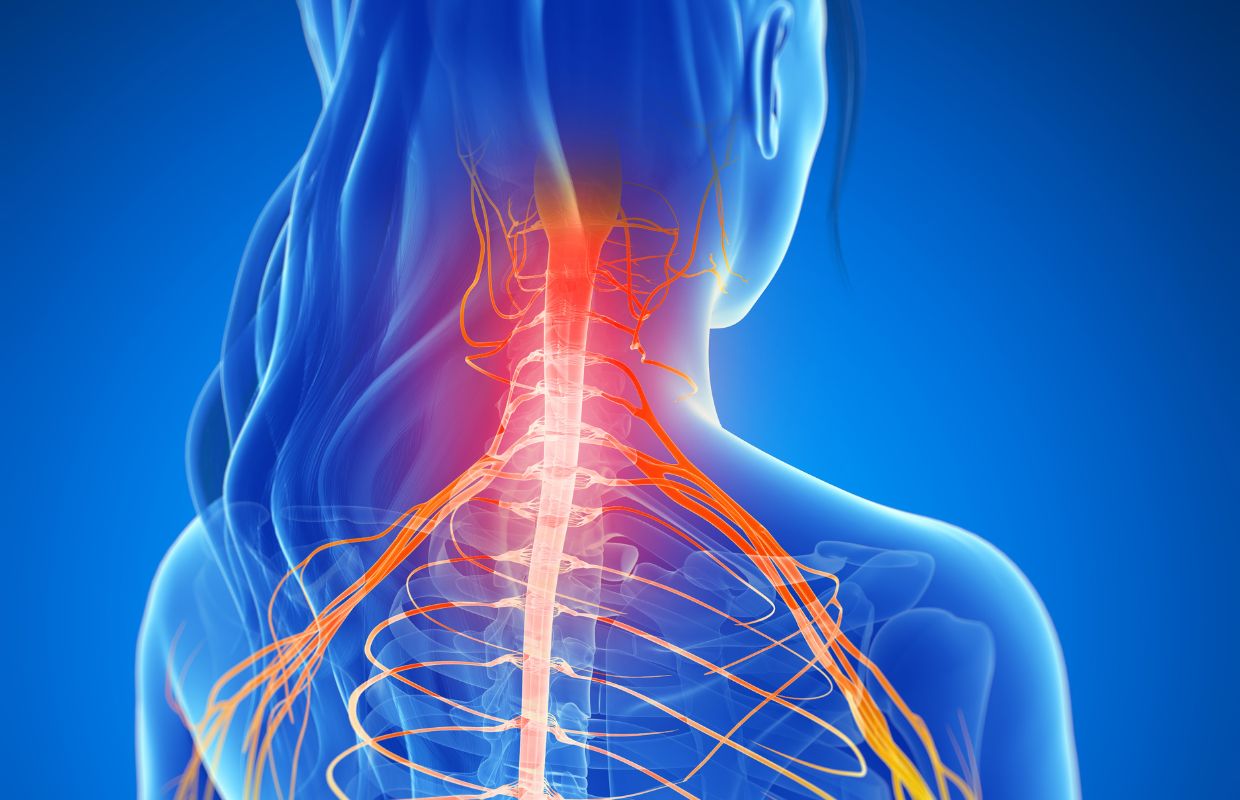
Is Screen Time Hurting Your Back and Neck?
Imagine a day without your smartphone, laptop, or TV. It seems almost impossible, right? These devices have become inseparable in our lives, providing endless entertainment, helping us stay connected, and supporting our work. But have you ever stopped to consider how our constant attachment to screens affects our health, particularly our posture and spinal well-being?
The truth is we’re so absorbed in the digital world that we often overlook the consequences it can have on our bodies. Spending hours absorbed in our devices can be detrimental, leading to discomfort in our shoulders, neck, and beyond, with potential long-term effects on our overall health.
In this blog, we’ll delve into the effects of technology on our posture and spinal health. We’ll explore practical strategies to minimize the negative consequences, such as stretches for upper back pain, to find a healthier balance between our digital lives and physical well-being.
What Is Screen Time?
Screen time refers to the total amount of time we spend interacting with screens and electronic devices, such as smartphones, tablets, computers, gaming consoles, and television. From scrolling through social media and sending texts to playing games and watching videos, screen time includes a wide range of activities that keep us glued to our devices.
The truth is we often spend most of our waking hours engaged with screens without even realizing it. But it’s important to pause and reflect on the impact of this continuous screen time on our bodies. The more time we spend hunched over screens, the more strain we put on our posture and spinal health. By understanding the concept of screen time and its effects, we can begin to take steps toward finding a healthier balance.
The Effects of Screen Time on Your Neck, Back, and Posture
When it comes to the impact of screen time on our bodies, certain areas are particularly affected: the neck and back. These regions bear the brunt of prolonged screen usage, leading to discomfort and postural issues.
Neck
Text Neck: Spending extended periods hunched over screens, particularly smartphones, can result in “text neck.” This condition involves forward head posture and increased strain on the neck muscles, ligaments, and discs. The weight of the head is meant to be evenly distributed over the spine, but when the head is constantly tilted forward, it places excessive stress on the neck.
Neck Discomfort: The repetitive motion of looking down at screens without proper alignment can strain the neck’s delicate structures. The muscles in the neck and upper back can become overworked and fatigued, causing discomfort and a restricted range of motion.
Back
Upper Back Discomfort: Slouching or rounding the shoulders while using devices can cause discomfort in the upper back region. This posture places excessive stress on the muscles and ligaments, leading to muscle imbalances and potential spinal misalignment. Stretches for upper back soreness guided by a stretch practitioner are recommended in these cases.
Lower Back Aching: Sitting for prolonged periods at a desk or while using screens can contribute to lower back discomfort. Poor sitting posture, such as slumping or not properly supporting the lower back, can strain the spinal discs and lead to muscle tension in the lower back area.
Posture
Rounded Shoulders: Frequently hunching over screens can cause the shoulders to round forward, leading to a stooped or slouched posture. This can weaken the back muscles and contribute to poor spinal alignment. Rounded shoulders can also affect the positioning of the head, increasing strain on the neck and upper back.
Forward Head Posture: Tilting the head forward to view screens, especially with laptops and smartphones, can result in a forward head posture. This misalignment increases neck and upper back strain, potentially leading to muscle tension and discomfort.
The Effects of Specific Devices on Your Health
Now, let’s explore how each specific device affects our neck, back, and posture:
Smartphones
Constantly looking down at smartphone screens can contribute to text neck and poor posture due to the forward head and rounded shoulder positions. The average human head weighs around 10-12 pounds. When tilted forward, the effective weight on the neck and spine can increase significantly, putting strain on the supporting structures.
Laptops and Desktop Computers
The screen and keyboard positions, as well as the height and support of the chair, play a significant role in contributing to back and posture problems. Using a laptop positioned too low can cause the user to hunch over, straining the muscles in the upper back and neck.
Gaming Consoles
Gamers often adopt a slouched posture while engrossed in the game, leading to muscle imbalances and postural problems. Additionally, repetitive movements associated with gaming can strain the wrists and hands, leading to discomfort and potential injuries.
Television
Sitting for long durations without proper support can lead to muscle imbalances, decreased spinal flexibility, and discomfort. Additionally, the position of the television, such as being too high or too low, can cause strain on the neck as the viewer adjusts their head position to see the screen.
Tablets
Improper tablet usage, such as holding it at an awkward angle or resting it on the lap, can be harmful. Having a tablet too low or bending the neck for extended periods can strain the neck and upper back muscles excessively, leading to discomfort.
It’s important to be mindful of our body positioning, incorporate regular breaks, perform stretches for upper back pain, and make ergonomic adjustments to promote better spinal health.
Using Technology Correctly for Better Back and Neck Health
It’s essential to use our devices to promote better health and minimize the negative impact of technology on our neck, back, and posture.
Maintain Proper Posture
One of the key factors in maintaining good spinal health is adopting and maintaining proper posture. Pay attention to the following guidelines:
- Sit up straight with your shoulders back and relaxed. Avoid slouching or slumping forward.
- Keep your head aligned with your spine, avoiding excessive tilting or craning. Imagine a string pulling you gently upward from the crown of your head.
- Engage your core muscles to support your spine. This helps distribute the load evenly and reduces strain on your back.
Set Up an Ergonomic Workstation
This can greatly alleviate the strain on your neck and back. Consider the following adjustments:
- Adjust your chair height so your feet are flat on the floor or a footrest. This helps maintain proper alignment of your spine.
- Position your monitor at eye level to avoid straining your neck. Use a monitor stand or stack books to achieve the desired height.
- Place your keyboard and mouse within easy reach and at a comfortable height to minimize strain on your arms, shoulders, and wrists.
Take Regular Breaks
Sitting for long periods without movement can contribute to muscle fatigue and stiffness. Incorporate regular breaks into your screen time routine:
- Every 30 minutes, take a short break to stand up, stretch, and move around. This allows your muscles to relax and promotes blood circulation.
- Use break time to perform exercises that strengthen your back and core muscles. Simple exercises like standing back extensions, shoulder retractions, and gentle twists can help alleviate tension and improve posture.
- Perform gentle stretches for upper back pain to relieve stiffness and maintain flexibility. Gentle side-to-side neck movements, chin tucks, and shoulder rolls can help relax the muscles in these areas.
Use Supportive Pillows
Using devices in bed can often lead to poor neck and back alignment. To promote better spinal health, consider the following:
- When using a smartphone or tablet in bed, prop yourself up with supportive pillows. This helps maintain a more neutral position for your neck and spine.
- Ensure your neck and spine are properly aligned while lying down. Avoid excessive twisting or bending of your neck to reduce strain on the muscles and joints.
Limit Screen Time
While it may be challenging, being mindful of how much time you spend using devices is crucial for your overall well-being. Consider the following tips:
- Take regular breaks from screens and engage in other activities that promote physical exercise and mental well-being. Go for a walk, engage in hobbies, or spend quality time with loved ones.
- Create boundaries and set limits on your screen time. This can help reduce the sedentary behavior associated with prolonged device use and encourage a more balanced lifestyle.
Warning Signs: When It’s Time to Check on Your Spinal Health
It’s crucial to pay attention to warning signs that indicate the need to prioritize our spinal health. Ignoring these signs can lead to further discomfort and potential long-term issues.
Here are some warning signs to be aware of:
Persistent Neck and Back Discomfort
If you experience ongoing neck or back discomfort that doesn’t seem to subside, it may be a sign that your screen time habits are negatively impacting your spine. Take note of the frequency, intensity, and duration of the soreness to discuss with a healthcare professional.
Headaches and Eye Strain
Frequent headaches or eye strain can be a result of excessive screen time. Straining your eyes to focus on digital screens for extended periods can lead to discomfort and fatigue. If you notice these symptoms, it may be time to reassess your device usage and incorporate regular breaks.
Stiffness and Reduced Flexibility
If you notice a decrease in your overall flexibility or increased stiffness in your neck, shoulders, or back, it could result from prolonged screen time. Regular movement and stretching exercises can help combat these issues and improve spinal health.
Numbness or Tingling Sensations
Experiencing numbness or tingling sensations in your hands, arms, or fingers may indicate nerve compression or repetitive strain injuries caused by improper device usage. Seek medical advice if you experience these symptoms.
Fatigue and Lack of Energy
Extended periods of device use can contribute to physical and mental fatigue. If you find yourself feeling drained, lacking energy, or having trouble concentrating, it’s essential to evaluate your screen time habits and incorporate healthy breaks and activities into your routine.
Relieving Back and Neck Discomfort
To alleviate a sore back caused by excessive screen time, consider the following interventions guided by professionals:
Ergonomic Assessment
An ergonomic assessment involves thoroughly evaluating your workstation setup and daily habits to identify any contributing factors to your discomfort. A specialist, such as an ergonomics expert or occupational therapist, can assess your posture, desk setup, chair ergonomics, and other relevant factors. Based on their findings, they can provide recommendations and modifications to optimize your workspace and reduce strain on your back and neck.
Heat or Cold Therapy
Applying heat or cold therapy to the affected area can help reduce soreness and inflammation. Heat therapy, such as using a heating pad or taking warm showers, can help relax muscles and improve blood flow. Cold therapy, like using ice packs or cold compresses, can numb the area and reduce swelling. Your healthcare provider can guide you on using heat or cold therapy appropriately based on your specific condition.
Practitioner Assisted Stretching
Practitioner assisted stretching, performed by a trained professional, can be highly beneficial for relieving back discomfort. This involves targeted stretches and mobilization techniques to release muscle tension, improve flexibility, and promote spinal alignment. Seeking assistance from a certified stretch practitioner can provide personalized guidance and maximize the benefits of stretching exercises such as stretches for upper back pain.
Other Interventions
Depending on the severity and underlying cause of your back discomfort, healthcare professionals may recommend additional interventions:
- Medications: Non-prescription medication like acetaminophen or NSAIDs can be used for short-term relief of mild to moderate discomfort. In some cases, prescription medications may be necessary to manage more severe discomfort.
- Injections: Corticosteroid injections or nerve blocks may be considered for targeted discomfort relief in specific cases, such as nerve impingement or inflammation.
- Surgical consultation: In rare cases where conservative measures have been ineffective, and the aching is persistent and debilitating, a surgical consultation with an orthopedic surgeon or neurosurgeon may be warranted. They can evaluate your condition and discuss potential surgical options.
Find Relief with Stretches for Upper Back Pain
Ready to relieve your back and neck aches and improve your posture? Contact Stretch Zone today to discover the benefits of practitioner-assisted stretching and schedule your free session. Don’t let screen time hinder your well-being any longer and take the first step toward a better posture!



